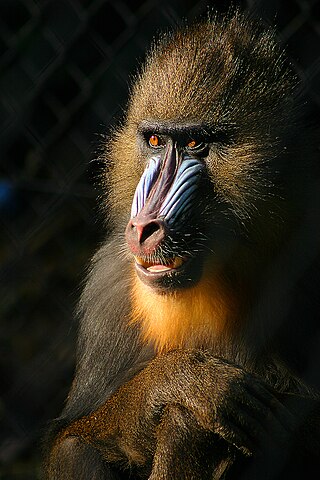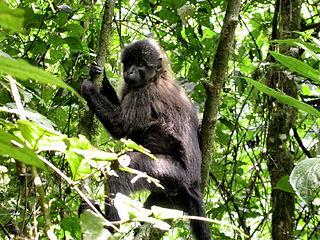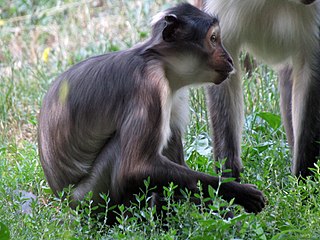
The Cercopithecinae are a subfamily of the Old World monkeys, which comprises roughly 71 species, including the baboons, the macaques, and the vervet monkeys. Most cercopithecine monkeys are limited to sub-Saharan Africa, although the macaques range from the far eastern parts of Asia through northern Africa, as well as on Gibraltar.

The golden-bellied mangabey is a social Old World monkey found in swampy, humid forests south of the Congo River in the Democratic Republic of the Congo. It was previously considered a subspecies of the agile mangabey . Little is published about the species and its behaviour has only been studied in captivity.

The grey-cheeked mangabey, also known as the white-cheeked mangabey, is an Old World monkey found in the forests of Central Africa. It ranges from Cameroon down to Gabon. The grey-cheeked mangabey is a dark monkey, looking in shape overall like a small, hairy baboon. Its thick brown fur is almost black in its forest home, with a slightly rufus/golden mane around the neck. The sexes are similar, with the males slightly larger than the females.

Mangabeys are West African Old World monkeys, with species in three of the six genera of tribe Papionini.

The kipunji, also known as the highland mangabey, is a species of Old World monkey that lives in the highland forests of Tanzania. The kipunji has a unique call, described as a 'honk-bark', which distinguishes it from its relatives, the grey-cheeked mangabey and the black crested mangabey, whose calls are described as 'whoop-gobbles'.

The sooty mangabey is an Old World monkey found in forests from Senegal in a margin along the coast down to the Ivory Coast.

The crested mangabeys are West African Old World monkeys belonging to the genus Lophocebus. They tend to have dark skin, eyelids that match their facial skin, and crests of hair on their heads. Another genus of mangabeys, Cercocebus, was once thought to be very closely related, so much so that all the species were placed in one genus. However, Lophocebus species are now understood to be more closely related to the baboons in genus Papio, while the Cercocebus species are more closely related to the mandrill. In 2006, the highland mangabey was moved from Lophocebus to a new genus, Rungwecebus.

The white-eyelid mangabeys are African Old World monkeys belonging to the genus Cercocebus. They are characterized by their bare upper eyelids, which are lighter than their facial skin colouring, and the uniformly coloured hairs of the fur. The other two genera of mangabeys, Lophocebus and Rungwecebus, were once thought to be very closely related to Cercocebus, so much so that all the species were placed in one genus, but Lophocebus and Rungwecebus species are now understood to be more closely related to the baboons in genus Papio, while the Cercocebus species are more closely related to the mandrill.

The Uganda mangabey is a subspecies of the grey-cheeked mangabey, an Old World monkey, found only in Uganda and in the Minziro Forest Reserve, just over the border in Tanzania. Colin Groves upgraded the Ugandan population of this crested mangabey to the new species L. ugandae on 16 February 2007, but this is not widely accepted. This subspecies is significantly smaller than the other subspecies of grey-cheeked mangabey, with a shorter skull and smaller face. 2018 was the most recent year in which the International Union for Conservation of Nature assessed the conservation status of L. albigena ugandae, describing it as being of vulnerable.

Papionini is a tribe of Old World monkeys that includes several large monkey species, which include the macaques of North Africa and Asia, as well as the baboons, geladas, mangabeys, kipunji, drills, and mandrills, which are essentially from sub-Saharan Africa. It is typically divided into two subtribes: Macacina for the genus Macaca and its extinct relatives and the Papionina for all other genera.

The black scimitarbill, also known as the black wood hoopoe, is a species of bird in the family Phoeniculidae.

The collared mangabey, also called red-capped mangabey and white-collared mangabey is a species of primate in the family Cercopithecidae of Old World monkeys. It formerly included the sooty mangabey as a subspecies. As presently defined, the collared mangabey is monotypic.

The black crested mangabey is a species of primate in the family Cercopithecidae. It is only found in Democratic Republic of the Congo with a small habitat extending to Angola. Its natural habitat is subtropical or tropical dry forests. It is threatened by habitat loss.

The agile mangabey is an Old World monkey of the white-eyelid mangabey group found in swampy forests of Central Africa in Equatorial Guinea, Cameroon, Gabon, Central African Republic, Republic of Congo, and DR Congo. Until 1978, it was considered a subspecies of the Tana River mangabey. More recently, the golden-bellied mangabey has been considered a separate species instead of a subspecies of the agile mangabey.
Johnston's mangabey is a subspecies of the gray-cheeked mangabey, a crested mangabey in the family Cercopithecidae. It was elevated to full species status in 2007, alongside Osman Hill's mangabey and the Uganda mangabey, but is still generally considered as a subspecies.

The Osman Hill's mangabey, also known as the rusty-mantled mangabey, is a subspecies of the grey-cheeked mangabey, a crested mangabey in the family Cercopithecidae, with a restricted distribution in West Africa.
Synodontis aterrimus, known as the network synodontis, is a species of upside-down catfish that is endemic to the Democratic Republic of the Congo where it is found in the middle Congo Basin. It was first described by Max Poll and Tyson R. Roberts in 1968. The original specimens were obtained in Bokuma, on the Congo River in what is now the Democratic Republic of the Congo. The species name aterrimus means "very black", referring to the dark coloration on the underside of the body.

The Eastern Congolian swamp forests are a fairly intact but underresearched ecoregion of the tropical and subtropical moist broadleaf forests biome. It is located within the Democratic Republic of the Congo. This is the eastern half of one of the largest areas of swamps in the world.














